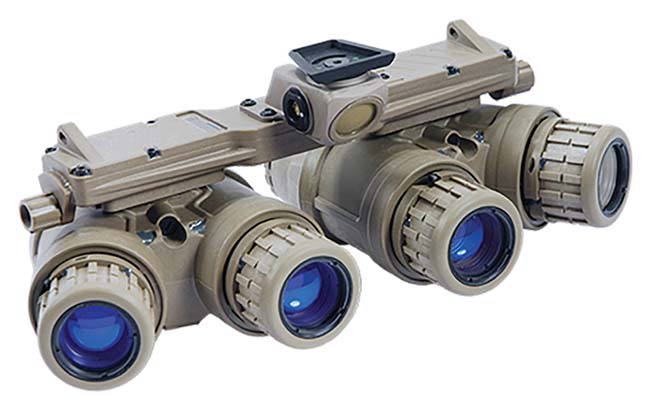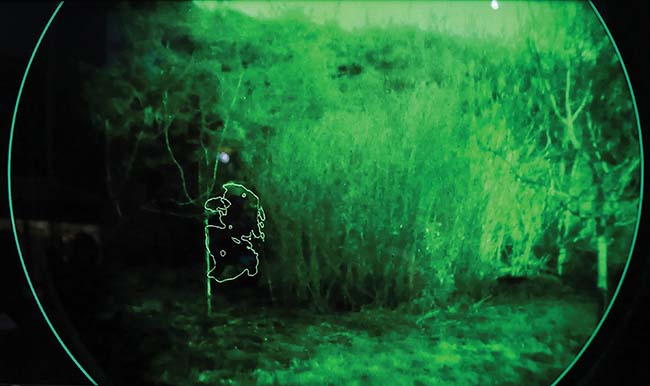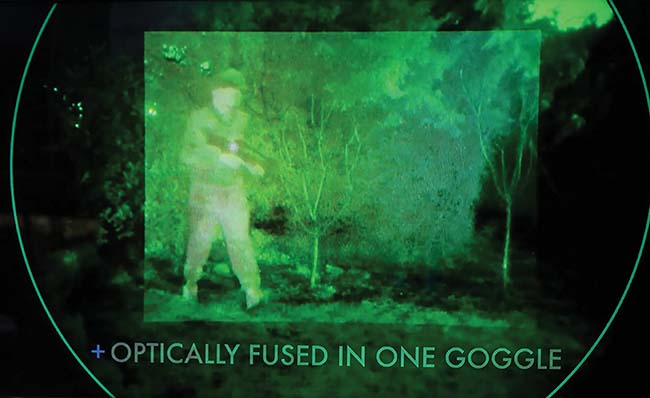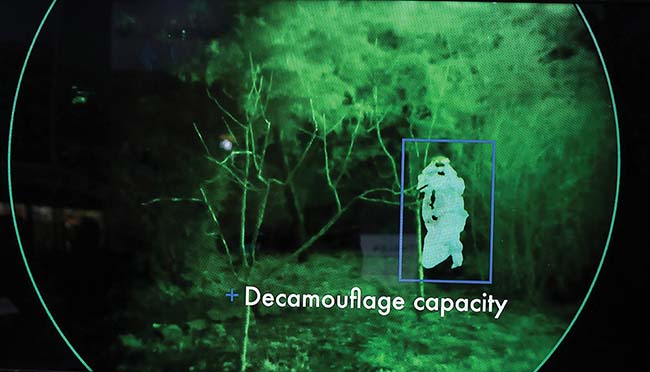ABOVE: February 2017, Northern lights, an ice cold night in Finnmark, Northern Norway. Norwegian soldiers from Infantry Battalion 2 are trying to locate the “enemy” during ex “Rein.” (OLE-SVERRE HAUGLI/NORWEGIAN ARMED FORCES)
Combat Ability 24/7
The sniper teams have to operate regardless of light and weather conditions. Night vision devices provide enormous benefits. They enable personnel to carry out operations under conditions that would not otherwise be possible. However, these benefits carry considerable risks. For instance, individuals often become over confident about their ability to use image intensification and infrared devices. In consequence, the use of night vision equipment is an increasingly common factor in military incidents and accidents. Fire ‘Blue’ against ‘Blue’ or innocent civilians is intolerable, even at night.
Clear identification of the enemy has become vital. Armies have invested heavily to procure ever better night-vision systems and improved training for night combat. Night vision capability enables soldiers to see their surroundings in low or no light conditions, but that’s not good enough. Soldiers must have night combat capability which enables them to take aim and to operate their weapons or weapon system effectively in no light conditions.
This article describes different night vision technology and some night vision goggles.
Different Systems
Light Intensifier (I²): There is usually always a little bit of light, even from the moon or stars, so these systems intensify the little light that there is to give an image. However, they will not function inside a dark room, for example, and will require the use of IR beamers. Photons in the near-infrared spectrum (approx. 750 to 950nm), which is invisible to the human eye, are collected and collimated in the objective lens and converted by a photocathode into electrons. A micro-channel plate then amplifies these electrons by a zillion-fold and transforms them into visible light appearing on a phosphor screen. According to the laws of optics, the resulting image is upside down and must be turned around with another lens in front of the eyepiece. The assembly of the photocathode, micro-channel plate and phosphor screen is called a “tube.”
Infrared Detectors are based on the principle of thermography. They respond to emanations in the medium IR-spectrum (3,000 to 5,000nm) from objects of differing temperatures and convert temperature differences into an image even in total darkness. Compared to light intensifiers, infrared detectors do without low light or artificial light sources, provide larger effective ranges and have proven to be significantly superior in detecting human targets and identifying vehicle targets. The range of application of this technology covers all conceivable platform-based and platform-independent systems. The image is produced by displaying in different grey scales or pseudo colors the thermal differences in the observed environment. In general, two categories of infrared detectors can be distinguished: cooled and uncooled.
Cooled Infrared Detectors work with a micro-bolometer, an infrared imaging sensor that converts infrared radiation into visible images by heating the proton when it hits the detector. Cooled infrared detectors have the advantage that they sense and depict environmental temperature differences much more precisely than I². Accordingly, they detect and identify potential targets at a much greater distance than non-cooled devices. Before they can display an image, the sensors of a cooled infrared detector have to be brought to their respective operating temperature. This consumes both time and energy. While the cooling process with previous generation devices took several minutes, modern devices are operable after no more than a few seconds. The older additional cooling system made these devices heavier, more energy-consuming and more expensive compared to uncooled systems. However, the state-of-the-art enables the production of compact cooled infrared detectors with a total weight of less than 2kg, making this technology also suitable for infantry operations. Handheld or weapon-attached observation devices enable the detection and identification of individuals at maximum ranges of 4,000m and 1,500m, respectively.
Uncooled Infrared Detectors: Doing away with the cooling system and the attached power supply not only lowers the purchase price, it also allows a significantly more compact infrared detector design with a total weight of just a few hundred grams. Yet this cost saving is bought at the expense of performance. Individuals can be detected and identified only at maximum ranges of 1,800m and 500m, respectively.
Modern Night Vision Goggles
Night vision goggles are available in generation 1, 2 and 3 technologies. Irrespective of their generation, all modern NVGs are based on the same functional principle: Photons in the near-infrared spectrum (approx. 750 to 950nm), which is invisible to the human eye, are collected and collimated in the objective lens and converted by a photocathode into electrons. A micro-channel plate then amplifies these electrons by a zillion-fold and transforms them into visible light appearing on a phosphor screen. According to the laws of optics, the resulting image is upside down and must be turned around with another lens in front of the eyepiece. The assembly of photocathode, micro-channel plate and phosphor screen is called a “tube.” Night goggles are available in four configurations: monocular, binocular, binocular and quad-eye and are worn using a headset or mounted on a helmet.
Monocular Goggle
The monocular goggle is basically the hand held monocular but worn on the head. It’s usually the least expensive of the night goggle types, but you still look through it using only one eye.
Biocular Goggle
The biocular goggle configuration is basically a night vision monocular with two eye pieces. It’s easier to use than a monocular because the user doesn’t have to keep one eye closed when using. The two-eyepiece lense makes it appear more natural to the wearer of the goggles. Nonetheless, such goggles fail to provide a stereoscopic view, especially at close range.
Binocular Goggle
Binoculars represent a third type of goggles. The two synchronized channels of such binocular goggles produce an image that agrees considerably more with reality than monocular or biocular goggles do. As such goggles correctly indicate ranges, they can also be worn by vehicle drivers. The use of a second tube makes these goggles almost twice as expensive to procure but offers the advantage of retaining a monocular night vision capability for the soldier should one of the tubes fail.
Quad-Eye Goggles
Quad-eye goggles are currently right out in front of the light-intensifier evolution and are therefore issued only to Special Forces, like the Seal Team 6-Operation “Neptune Spear” [Osama bin Laden]. Four separate and synchronized input channels generate a horizontal field of vision of more than 90 degrees which comes closest to the natural 120-degree field of view of human beings (Source: IEA MIL-OPTICS GmbH/Waldemar Geiger, Mittler Report Verlag GmbH).
Quad-Eye Goggles GPNVG-18 by L-3 Warrior System
These provide the warrior with more information seen in the goggles, allowing him to quickly move through the OODA process (Observe, Orient, Decide and Act). The GPNVG-18 by L-3 Warrior System has four separate image intensifier tubes with four separate objective lenses. The whole package weighs just over 700g which is considerably lighter than many monoculars. The central two lenses point forward like traditional dual-tube goggles, giving the operator more depth perception, while the tubes on either side point outward from the center to increase peripheral view. The two tubes on the right and the two on the left are spliced at the eyepieces. The operator sees the images from the two outer tubes slightly overlapping those of the two central ones providing him with an unprecedented 97o field of view. The two right and two left tubes are housed in merged assemblies but can be detached and operated as independent handheld viewers. The GPNVG-18 is powered by a remote battery pack and tethered to the unit via a standard cable. Battery life is approximately 30 hours; immersion in1m provides 2 hours.
Multi-function
In addition to the functions offered by the mono-function, these systems also include a GPS and a magnetic compass, so that the user knows where he is and in which direction the target lies, and a laser telemetry system to know how far away the target is. At the press of a button the user will get all the coordinates of the target. He can send these to his commanding officer together with a photograph of what he can see. The systems are thus part of a Battle Management System.

Harris F6044, Generation 3
This Tactical Mobility Night Vision Goggle (TM-NVG) is part of the i-Aware® family F6044 Series of advanced, multi-purpose night vision products connecting the battlefield user with various applications, as well as command headquarters, to enhance situational awareness. As part of a complete soldier system or as a stand-alone night vision goggle, i-Aware TM-NVG increases operational effectiveness in both nighttime and daytime missions and provides the soldier with real-time video access to critical tactical intelligence. i-Aware TM-NVG offers integrated, color imagery display and camera capture export capabilities. The configuration has these features:
- Provides enhanced tactical command and control for improved decision-making
- Allows tactical commanders real-time access to live soldier video feeds
- Enables viewing GPS, mapping, command text message and target information along with video input from weapon sights to “shoot around the corner”
- Integrates a camera system to capture and export live video from the warrior’s viewpoint
- The TM-NVG has an image field-of-view greater than 40o
- The battery life is (image intensified only) is greater than 15 hours
- The system weight is less than 2.2lb (1,000g) includes primary and secondary monocular (can be tilted up).
Fused Goggle System (FGS)
By combination of the light amplification capability of the image intensification device with the heat sensing capability of the thermal imaging system, fused goggle systems allow the operator to adjust the viewed image from 100% Image Intensification (I²) to 100% Thermal, or a varying mix of the two. The system amplifies available light and thermal signatures and fuses them together to produce a clear image under adverse conditions enabling target identification in light rain, smoke, snow, low light and total darkness. The FGS provides image resolution in situations where active infrared illumination is not an option.
Thales Group’s MINIE-D/IR Connected Fused Sensors NVG
The MINIE-D/IR is an image intensified (I²) night vision goggle associated to an uncooled thermal (IR) imaging module which allows it to fuse thermal and intensified images. This innovation by Thales offers to the soldier new capabilities essential to modern warfare.
The display presents an IR image in three available modes: “Full IR,” “Threshold” or “Contours,” with distinct colors for IR and I² allowing a more accurate interpretation of the fused image. This gives the warrior a unique de-camouflage capability and optimal situational awareness.
Key features:
- Magnification 1x, field of view I² 51°, focus range 20cm to infinity, diopter adjustment -6 to +3 diopters, eye relief 20mm
I² Tube Gen. II or Gen. III, optional brightness gain, manually adjustable - Field of view IR 36° (diagonal) IR sensor, field of view (data) 42.5° (diagonal), video input/video feeds (color)/overlay of data on IR image
- Weight 500g, battery life at 20°C (I² only /I²+IR), with single battery pack 40h/2.5h, with power supply pack 150h/18h
- Operating temperature -32°C to +44°C; storage temperature -46°C to +70°C; water immersion 1m for 2 hours.
Other features include built-in infrared illuminator with «IR-on» indicator, automatic cut-off in high light conditions and stowed position, “low battery” indicator and video setting mode (brightness, contrast, IR superimposing).
BAE Systems Combines NVGs with Thermal Targeting
Night vision and infrared detector attachments with crosshairs enable the soldiers to fight under limited visibility conditions, but they cannot be used in connection with night vision goggles. The shooter is forced to turn up his goggles every time before he takes his shooting position. This drawback not only involves additional motoric effort but also the loss of the panoramic field of view as the shooter has only the tunnel-type vision through the eyepiece. BAE Systems’ ENVG III / FWS-I integrated night vision solution wirelessly connects the goggle and weapon sight and provides rapid target acquisition capabilities. One of the key benefits of the ENVG/FWS-I solution is that it enables soldiers to acquire targets without putting their head in harm’s way.
Conclusion
Night time combat requires full operational effectiveness in varying environments. Image Intensifiers (I²) require some ambient illumination to operate effectively, but they are defeated by excess light such as from street lights or headlights, camouflage, vegetation, insufficient light on cloudy moonless nights, fog/smoke or complete darkness inside buildings. Thermal imaging is independent of light and operates in any level of darkness, fog or smoke but does not identify the features and textures shown by I².
The solution is to combine thermal imaging with image intensification for fused night vision in low light and complete darkness. Fused I2 and thermal technology is therefore ideal for dusk to night, heavy cloud coverage, forests/jungles and inside buildings as well as well-lit nighttime urban environments when over-amplification of light sources (e.g., car headlamps/streetlights) causes I2 devices to fail.
Fused night vision technology is the new standard for military operations to give 24-hour operational capability. The color fusion of low-light visible and thermal infrared imagery in real time has created a new era in night vision.
MINIE-D/IR Connected Fused Sensors Night Vision Goggle
Ultimate sensors’ combination enabling de-camouflage of potential threats while preserving mobility. Fast and easy mounting of the IR plug-in onto MINIE-D, in less than 5 seconds, to obtain genuine thermal imaging capability, improved situational awareness in any battlefield conditions. Has four available configurations–IL or IR only, fused IL/IR and video feeds display–according to every mission requirement. Various IR image display modes (Full IR, Threshold, Contours) to enhance target detection.













